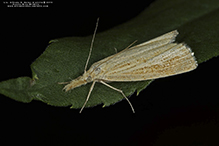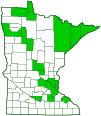Vagabond crambus
(Agriphila vulgivagellus)
Conservation • Description • Habitat • Ecology • Distribution • Taxonomy
| Hodges # | 5403 |
||
Conservation Status |
|||
| IUCN Red List | not listed |
||
| NatureServe | NNR - Unranked SNR - Unranked |
||
| Minnesota | not listed |
||
Description
Vagabond crambus is a medium-sized moth but one of the largest grass veneers. It occurs across the United States and southern Canada. It is common in Minnesota. Adults are found in grasslands, fields, and gardens. Larvae feed in the spring on fast-growing grasses and grains, including wheat and rye. They are not considered serious pests.
Adults are 11⁄16″ (18 mm) in length and have a wingspan of ¾″ to 1 9⁄16″ (20 to 39 mm).
The forewings are pale tan. They are sparsely to densely peppered with dark scales between the veins creating streaky patterns. There are no dark lines crossing the wing. The outer margin has seven black dots, one at the end of each vein. The fringe is variable. It may be gray or almost black, and often has some white. The apparent color may be affected by the angle of the light.
The antennae are slender and thread-like. The finger-like sensory organs (palps) attached to the mouth are very long and densely hairy. They are projected forward, appearing like a fuzzy snout.
The caterpillar ¾″ to 1″ long. It is green to brown with dark spots, coarse hairs, and a brown head.
Size
Total length: 11⁄16″ (18 mm)
Wingspan: ¾″ to 1 9⁄16″ (20 to 39 mm)
Similar Species
Habitat
Grasslands, fields, and gardens
Ecology
Season
One generation per year: August to October
Behavior
Adults rest with their wings held tight to the body, forming a tubular shape. They are active at night and will come to lights.
Life Cycle
Larvae overwinter
Larva Food/Hosts
Grasses and grains, including wheat and rye
Adult Food
Distribution |
||
|
Sources 6, 7, 21, 22, 24, 27, 29, 30, 71, 75, 82, 83. Biodiversity occurrence data published by: Minnesota Biodiversity Atlas (accessed through the Minnesota Biodiversity Atlas Portal, bellatlas.umn.edu, 9/29/2025). |
|
| 9/29/2025 | ||
Occurrence |
||
Common |
||
Taxonomy
Order
Lepidoptera (Butterflies and Moths)
Superfamily
Pyraloidea (Pyralid and Crambid Snout Moths)
Family
Crambidae (Crambid Snout Moths)
Subfamily
Crambinae (Grass-veneers and Allies)
Tribe
Crambini (Grass-veneers)
Genus
Agriphila
Subordinate Taxa
Synonyms
Agriphila aurifimbrialis
Agriphila chalybirostris
Common Names
Glossary
Palp
Short for pedipalp. A segmented, finger-like process of an arthropod; one is attached to each maxilla and two are attached to the labium. They function as sense organs in spiders and insects, and as weapons in scorpions. Plural: palpi or palps.
Visitor Photos
Share your photo of this insect.
This button not working for you?
Simply email us at info@MinnesotaSeasons.com.
Attach one or more photos and, if you like, a caption.
Alfredo Colon |

|
MinnesotaSeasons.com Photos
|

Slideshows

Visitor Videos
Share your video of this insect.
This button not working for you?
Simply email us at info@MinnesotaSeasons.com.
Attach a video, a YouTube link, or a cloud storage link.
Other Videos
Vagabon Crambus Moth (Crambidae: Agriphila vulgivagellus?) Lateral View
Carl Barrentine



